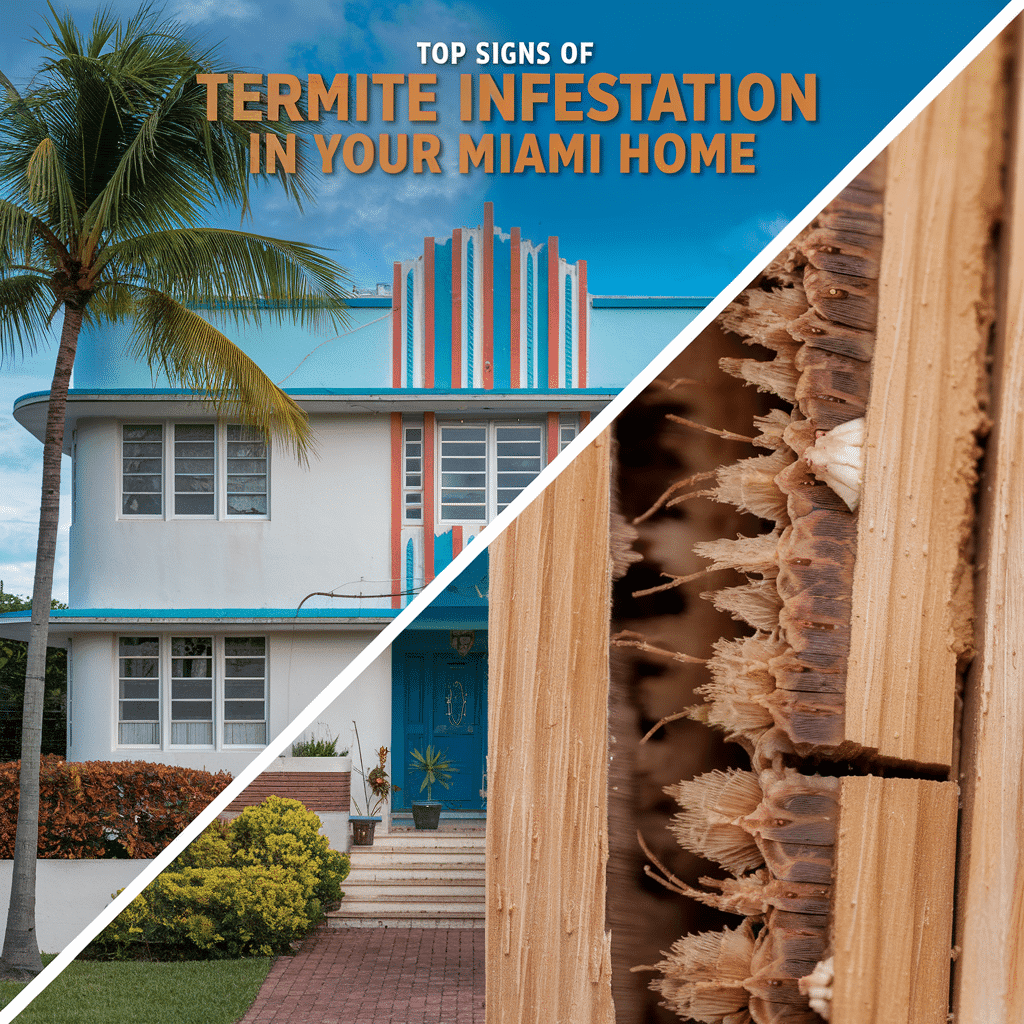As a homeowner in Miami, you’re no stranger to the unique challenges that come with living in this vibrant, tropical paradise. From the stunning beaches of South Beach to the lush greenery of Fairchild Tropical Botanic Garden, our city is a haven for both humans and, unfortunately, termites. These tiny yet destructive pests can wreak havoc on your home, potentially causing thousands of dollars in damage if left unchecked. In this comprehensive guide, we’ll explore the top signs of termite infestation, the types of termites common in South Florida, and why professional inspections are crucial for protecting your Miami home.
Common Indicators of Termite Activity
Detecting termite activity early can save you from extensive damage and costly repairs. Here are the key signs to watch out for:
1. Discarded Wings
One of the most telltale signs of termite infestation is the presence of discarded wings. During their mating season, which often coincides with Miami’s warm and humid spring, termites swarm to establish new colonies. After finding a suitable location, these winged termites (also known as alates) shed their wings. If you notice small, translucent wings near windowsills, doorways, or caught in spider webs around your home, it’s time to be on high alert. These discarded wings often resemble fish scales and can be found in areas like the art deco buildings of Ocean Drive or even near the iconic Vizcaya Museum and Gardens.
2. Mud Tubes
Subterranean termites, which are prevalent in Miami, construct mud tubes as protective tunnels to move between their colony and food sources. These tubes, about the width of a pencil, can be found along your home’s foundation, exterior walls, or even interior surfaces. Look for these mud tubes in areas where your home meets the ground, such as near the base of the Coral Castle or along the foundations of homes in historic Coconut Grove. The presence of these tubes is a clear indication of termite activity and warrants immediate attention.
3. Hollow-Sounding Wood
Termites eat wood from the inside out, leaving a thin veneer of wood or paint on the surface. This results in wood that sounds hollow when tapped. Test wooden structures in your home by gently tapping them with a screwdriver handle. If you hear a hollow sound, especially in areas like door frames, window sills, or baseboards, it could indicate termite damage. This is particularly important for homes in historic districts like Homestead or Coral Gables, where many structures feature beautiful, old woodwork that’s especially vulnerable to termite damage.
4. Frass (Termite Droppings)
Drywood termites, another common species in Miami, leave behind small, pellet-like droppings called frass. These droppings are often mistaken for sawdust or sand and can be found near infested wood or on surfaces below wooden structures. Look for small piles of these pellets in areas like attics, basements, or near wooden furniture. Homeowners in neighborhoods like Pinecrest or Kendall should be particularly vigilant, as the lush tree canopies in these areas can make homes more susceptible to drywood termite infestations.
5. Warped or Bubbling Paint
As termites consume wood and produce moisture, they can cause paint to bubble, peel, or appear water-damaged. This is often mistaken for actual water damage, but in Miami’s climate, it’s wise to consider termites as a potential cause.Inspect your walls, especially in areas prone to moisture like bathrooms or kitchens. If you notice warping or bubbling paint without an apparent water source, it could be a sign of termite activity behind the walls.
6. Tight-Fitting Doors or Windows
As termites consume wood, they can cause doors and windows to become misaligned. If you suddenly find it difficult to open or close doors and windows that previously worked fine, it could be due to termite damage warping the wood frames.This is particularly common in older Miami homes, such as those in the MiMo District or Morningside, where original wooden structures may be more susceptible to termite damage.
7. Visible Termites
While it’s rare to see termites themselves, it’s not impossible. During swarming season, you might spot winged termites around light sources. If you see what looks like white ants inside wood when doing home repairs or renovations, those are likely termites.Keep an eye out for these pests, especially if you live near termite-prone areas like the mangroves of Oleta River State Park or the wooded areas of Matheson Hammock Park.
Types of Termites Found in South Florida
Understanding the types of termites common in our area can help you better protect your home. Miami is home to several termite species, each with its own characteristics and potential for damage.
1. Subterranean Termites
Subterranean termites are the most destructive and common type in Miami. They live in the soil and build extensive underground colonies. These termites construct the mud tubes mentioned earlier to protect themselves as they travel between their nest and food sources.
Native Subterranean Termites: These are smaller and cause damage more slowly than their invasive counterparts. However, they can still cause significant harm over time.
Formosan Subterranean Termites: Often called “super termites,” Formosan termites are an invasive species known for their large colonies and aggressive feeding habits. They can cause extensive damage in a short period and are a significant concern for Miami homeowners.
Asian Subterranean Termites: Another invasive species, Asian subterranean termites, are becoming increasingly prevalent in South Florida. They’re known for their ability to infest live trees, making them a threat to both structures and landscaping.
2. Drywood Termites
Drywood termites don’t need contact with soil and can infest dry wood directly. They’re common in Miami’s warm climate and can often be found in attics, wooden furniture, and structural timbers.
West Indian Drywood Termites: This is the most common drywood termite species in South Florida. They can cause significant damage to homes and furniture.
Florida Drywood Termites: A native species that’s less common but still a threat to wooden structures.
3. Dampwood Termites
While less common than the other types, dampwood termites can be found in Miami, especially in areas with high moisture content. They prefer wet, decaying wood and are often found in homes with water damage or leaks.
Importance of Professional Termite Inspections
While being aware of the signs of termite infestation is crucial, nothing beats the expertise of a professional termite inspection. Here’s why regular professional inspections are essential for Miami homeowners:
1. Early Detection
Professional inspectors are trained to spot even the subtlest signs of termite activity. They can identify potential infestations before they become severe, saving you from extensive damage and costly repairs. This is particularly important in Miami, where the warm, humid climate creates ideal conditions for year-round termite activity.
2. Comprehensive Evaluation
A professional inspection covers areas of your home that you might not think to check or can’t easily access. Inspectors will examine your entire property, including crawl spaces, attics, and the home’s exterior. They’ll look for signs of both active infestations and conditions that might attract termites in the future.
3. Accurate Identification
With several termite species present in Miami, accurate identification is crucial for effective treatment. Professional inspectors can distinguish between different termite types and other wood-destroying insects, ensuring that the right treatment plan is implemented.
4. Advanced Detection Methods
Professional inspectors use specialized tools and techniques that go beyond visual inspection. These may include moisture meters, infrared cameras, and even termite-sniffing dogs. These advanced methods can detect termite activity hidden within walls or other hard-to-reach areas.
5. Customized Prevention Plans
Based on their findings, professional inspectors can provide customized recommendations for preventing future infestations. This might include suggestions for landscaping changes, moisture control, or structural modifications to make your home less attractive to termites.
6. Peace of Mind
Regular professional inspections give you peace of mind, knowing that your home is protected against these destructive pests. This is especially valuable in Miami’s real estate market, where termite inspections are often required for property sales and can impact home values.
7. Cost-Effective in the Long Run
While professional inspections come with a cost, they’re a wise investment compared to the potential expense of repairing severe termite damage. In Miami, where the average cost of termite damage repair can run into thousands of dollars, regular inspections are a cost-effective preventive measure.
Protecting Your Miami Home from Termites
Living in Miami means embracing our unique ecosystem, from the bustling streets of Brickell to the serene waters of Biscayne Bay. However, it also means being proactive about protecting our homes from termites. Here are some additional tips to keep your Miami home termite-free:
- Reduce Wood-to-Ground Contact: Ensure that wooden structures, including fences and deck posts, don’t come into direct contact with the soil. This is especially important for homes near wooded areas like Tropical Park or Greynolds Park.
- Control Moisture: Fix leaks, improve drainage, and use dehumidifiers in damp areas. This is crucial in Miami’s humid climate, particularly during our rainy seasons.
- Remove Cellulose Sources: Keep firewood, lumber, and paper away from your home’s foundation. If you live near areas like the Everglades or Oleta River State Park, be extra vigilant about removing potential food sources for termites.
- Use Termite-Resistant Materials: When building or renovating, consider using termite-resistant materials, especially for structures close to the ground.
- Regular Maintenance: Keep your home well-maintained. Repair damaged roof tiles, siding, and weather stripping promptly to prevent termite entry points.
- Landscaping Considerations: Maintain a gap between your home’s foundation and any mulch or dense vegetation. This is particularly important for homes with lush gardens, like those in Coral Gables or Coconut Grove.
- Professional Treatment: Consider professional preventive treatments, especially if you live in high-risk areas or have had termite problems in the past.
Conclusion
Termites may be small, but their impact on Miami homes can be enormous. From the art deco buildings of South Beach to the modern high-rises of Downtown, no structure is immune to these persistent pests. By staying vigilant for the signs of termite infestation, understanding the types of termites common in our area, and investing in regular professional inspections, you can protect your Miami home from these destructive invaders. Remember, in our vibrant city where the natural world is always just a step away – whether it’s the beaches of Key Biscayne or the trails of Matheson Hammock Park – coexisting with nature means being proactive about pest control. Don’t wait until you see obvious signs of damage. Regular inspections and early intervention are key to maintaining the integrity and value of your Miami home. By taking these steps, you can ensure that your home remains a safe, beautiful haven in our tropical paradise, free from the worry of termite damage. After all, there’s nothing quite like enjoying a peaceful evening on your termite-free porch, watching the sun set over the Miami skyline, knowing your home is protected for years to come.

17 Years of Pest Control Experience Founder and Owner of Dade Pest Solutions Proud Resident of South Florida
Shaun Judy, a dedicated South Florida native, is the founder and driving force behind Dade Pest Solutions. With over 17 years of hands-on experience in the pest control industry, Shaun has built a reputation for reliability, results, and real local knowledge. His journey began with a deep commitment to protecting homes from pests using proven methods and innovative solutions. Raised with a strong work ethic and a passion for service, Shaun treats every property as if it were his own—delivering expert care with a personal touch.

